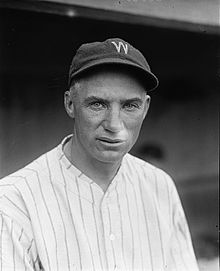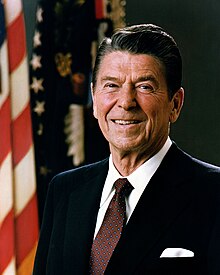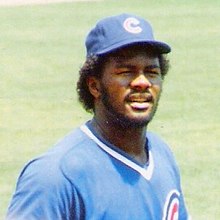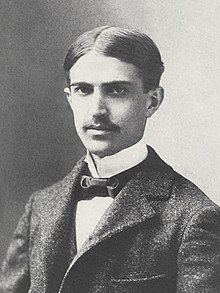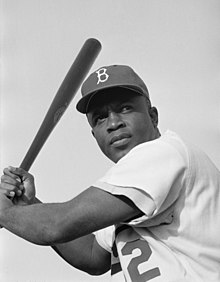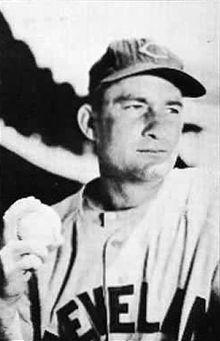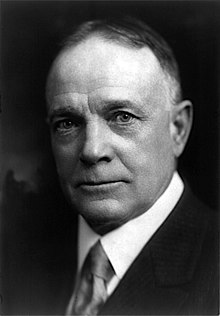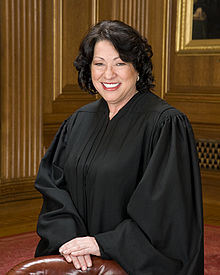Portal:Baseball
Portal maintenance status: (June 2018)
|
| Main page | Content, Categories & Topics | WikiProjects & Things you can do |
The Baseball Portal
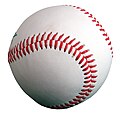
Baseball is a bat-and-ball sport played between two teams of nine players each, taking turns batting and fielding. The game occurs over the course of several plays, with each play generally beginning when a player on the fielding team, called the pitcher, throws a ball that a player on the batting team, called the batter, tries to hit with a bat. The objective of the offensive team (batting team) is to hit the ball into the field of play, away from the other team's players, allowing its players to run the bases, having them advance counter-clockwise around four bases to score what are called "runs". The objective of the defensive team (referred to as the fielding team) is to prevent batters from becoming runners, and to prevent runners' advance around the bases. A run is scored when a runner legally advances around the bases in order and touches home plate (the place where the player started as a batter).
The opposing teams switch back and forth between batting and fielding; the batting team's turn to bat is over once the fielding team records three outs. One turn batting for each team constitutes an inning. A game is usually composed of nine innings, and the team with the greater number of runs at the end of the game wins. Most games end after the ninth inning, but if scores are tied at that point, extra innings are usually played. Baseball has no game clock, though some competitions feature pace-of-play regulations such as the pitch clock to shorten game time.
Baseball evolved from older bat-and-ball games already being played in England by the mid-18th century. This game was brought by immigrants to North America, where the modern version developed. Baseball's American origins, as well as its reputation as a source of escapism during troubled points in American history such as the American Civil War and the Great Depression, have led the sport to receive the moniker of "America's Pastime"; since the late 19th century, it has been unofficially recognized as the national sport of the United States, though in modern times is considered less popular than other sports, such as American football. In addition to North America, baseball spread throughout the rest of the Americas and the Asia–Pacific in the 19th and 20th centuries, and is now considered the most popular sport in parts of Central and South America, the Caribbean, and East Asia, particularly in Japan, South Korea, and Taiwan. (Full article...)
 Featured articles - load new batch
Featured articles - load new batch
-
Image 1
Stanley Anthony Coveleski (born Stanislaus Kowalewski, July 13, 1889 – March 20, 1984) was an American right-handed pitcher in Major League Baseball who played for four American League (AL) teams between 1912 and 1928, primarily the Cleveland Indians. The star of the Indians pitching staff, he won over 20 games each year from the war-shortened 1918 season through 1921, leading the AL in shutouts twice and in strikeouts and earned run average (ERA) once each during his nine years with the club. The star of the 1920 World Series, he led the Indians to their first title with three complete-game victories, including a 3–0 shutout in the Game 7 finale. Traded to the Washington Senators after the 1924 season, he helped that club to its second AL pennant in a row with 20 victories against only 5 losses, including a 13-game winning streak, while again leading the league in ERA.
Coveleski followed in the footsteps of his brother Harry as a major league pitcher. But after making his debut with the Philadelphia Athletics in 1912, he was sidetracked by three more seasons in the minor leagues before joining the Indians in 1916, and won only 13 major league games before turning 27. Coveleski specialized in throwing the spitball, where the pitcher alters the ball with a foreign substance such as chewing tobacco. It was legal when his career began but prohibited in 1920, with Coveleski being one of 17 pitchers permitted to continue throwing the pitch. In 450 career games, Coveleski pitched 3,082 innings and posted a record of 215–142, with 224 complete games, 38 shutouts, and a 2.89 ERA. He set Cleveland records of 172 wins, 2,502+1⁄3 innings and 305 starts, which were later broken by Mel Harder and Willis Hudlin. He was inducted into the Baseball Hall of Fame in 1969. (Full article...) -
Image 2Adenhart pitching for the Salt Lake Bees in 2008
Nicholas James Adenhart (August 24, 1986 – April 9, 2009) was an American right-handed baseball starting pitcher who played parts of two seasons in Major League Baseball (MLB) for the Los Angeles Angels of Anaheim. In just four career games, Adenhart pitched 18 innings and posted a win-loss record of 1–0.
A graduate of Williamsport High School, Adenhart was highly touted as a high school prospect until an injury in his final game required Tommy John surgery. The Angels drafted him in the 14th round of the 2004 Major League Baseball draft, and began playing in their minor league system after the surgery was a success. He spent three full seasons in the minor leagues before making his major league debut on May 1, 2008. After appearing in three games, Adenhart spent the rest of 2008 in the minor leagues developing his skills, and in 2009 he earned a spot in the Angels' starting rotation. (Full article...) -
Image 3
Ronald Wilson Reagan (February 6, 1911 – June 5, 2004) was an American politician and actor who served as the 40th president of the United States from 1981 to 1989. A member of the Republican Party, he became an important figure in the American conservative movement, and his presidency is known as the Reagan era.
Born and raised in Illinois, Reagan graduated from Eureka College in 1932 and was hired the next year as a sports broadcaster in Iowa. In 1937, he moved to California where he became a well-known film actor. During his acting career, Reagan was elected president of the Screen Actors Guild twice, serving from 1947 to 1952 and from 1959 to 1960. In the 1950s, he became the host for General Electric Theater and also worked as a motivational speaker for General Electric. Subsequently, Reagan's "A Time for Choosing" speech during the 1964 U.S. presidential election launched his rise as a leading conservative figure. After being elected governor of California in 1966, he raised the state taxes, turned the state budget deficit into a surplus and implemented harsh crackdowns on university protests. Following his loss to Gerald Ford in the 1976 Republican Party presidential primaries, Reagan won the Republican Party's nomination and then a landslide victory over President Jimmy Carter in the 1980 presidential election. (Full article...) -
Image 4
Lee Arthur Smith (born December 4, 1957) is an American former professional baseball pitcher who played 18 years in Major League Baseball (MLB) for eight teams. Serving mostly as a relief pitcher during his career, he was a dominant closer, was the first pitcher to reach 400 saves, and held the major league record for career saves from 1993 until 2006, when Trevor Hoffman passed his total of 478. He was elected to the National Baseball Hall of Fame as part of the class of 2019 by the Today's Game Era Committee.
A native of Jamestown in Bienville Parish in north Louisiana, Smith was scouted by Buck O'Neil and was selected by the Chicago Cubs in the 1975 MLB draft. Smith was an intimidating figure on the pitcher's mound at 6 feet 6 inches (1.98 m) and 265 pounds (120 kg) with a 95-mile-per-hour (150 km/h) fastball. In 1991, he set a National League (NL) record with 47 saves for the St. Louis Cardinals, and was runner-up for the league's Cy Young Award; it was the second of three times Smith led the NL in saves, and he later led the American League (AL) in saves once. When he retired, he held the major league record for career games finished (802) and was third in games pitched (1,022). He holds the Cubs' team record for career saves (180), and held the same record for the Cardinals (160) until 2006. (Full article...) -
Image 5
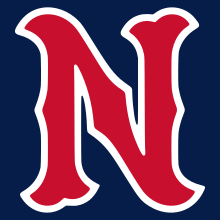
The Nashville Sounds are a Minor League Baseball team of the International League and the Triple-A affiliate of the Milwaukee Brewers. They are located in Nashville, Tennessee, and are named for the city's association with the music industry, specifically the "Nashville sound", a subgenre of country music which originated in the city in the mid-1950s. The team plays their home games at First Horizon Park, which opened in 2015 on the site of the historic Sulphur Dell ballpark. The Sounds previously played at Herschel Greer Stadium from its opening in 1978 until the end of the 2014 season. They are the oldest active professional sports franchise in Nashville.
Established as an expansion team of the Double-A Southern League in 1978, the Sounds led all of Minor League Baseball in attendance in their inaugural season and continued to draw the Southern League's largest crowds in each of their seven years as members. On the field, the team won six consecutive second-half division titles from 1979 to 1984 and won the Southern League championship twice: in 1979 as the Double-A affiliate of the Cincinnati Reds and again in 1982 as the Double-A affiliate of the New York Yankees. (Full article...) -
Image 6

James Robert "Loafer" McAleer (July 10, 1864 – April 29, 1931) was an American center fielder, manager, and stockholder in Major League Baseball who assisted in establishing the American League. He spent most of his 13-season playing career with the Cleveland Spiders, and went on to manage the Cleveland Blues, St. Louis Browns, and Washington Senators. Shortly before his retirement, he became a major shareholder in the Boston Red Sox. His career ended abruptly. During his brief tenure as co-owner of the Red Sox, McAleer quarreled with longtime friend and colleague Ban Johnson, president of the American League. In the wake of this disagreement, he sold off his shares in the Red Sox and broke off his relationship with Major League Baseball.
McAleer's rift with Johnson, along with his sudden retirement, damaged his professional reputation, and he received little recognition for his contributions to baseball. Today, he is most often remembered for initiating the customary request that the President of the United States throw out the first ball of the season. (Full article...) -
Image 7
Michael Jeffrey Jordan (born February 17, 1963), also known by his initials MJ, is an American businessman and former professional basketball player. He played 15 seasons in the National Basketball Association (NBA) between 1984 and 2003, winning six NBA championships with the Chicago Bulls. He was integral in popularizing basketball and the NBA around the world in the 1980s and 1990s, becoming a global cultural icon. His profile on the NBA website states, "By acclamation, Michael Jordan is the greatest basketball player of all time."
Jordan played college basketball with the North Carolina Tar Heels. As a freshman, he was a member of the Tar Heels' national championship team in 1982. Jordan joined the Bulls in 1984 as the third overall draft pick and quickly emerged as a league star, entertaining crowds with his prolific scoring while gaining a reputation as one of the best defensive players. His leaping ability, demonstrated by performing slam dunks from the free-throw line in Slam Dunk Contests, earned him the nicknames "Air Jordan" and "His Airness". Jordan won his first NBA title with the Bulls in 1991 and followed that achievement with titles in 1992 and 1993, securing a three-peat. Citing "physical and mental exhaustion" from basketball and superstardom, Jordan abruptly retired from basketball before the 1993–94 NBA season to play Minor League Baseball in the Chicago White Sox organization. He returned to the Bulls in March 1995 and led them to three more championships in 1996, 1997, and 1998, as well as a then-record 72 regular season wins in the 1995–96 NBA season. Jordan retired for the second time in January 1999, returning for two more NBA seasons from 2001 to 2003 as a member of the Washington Wizards. He was selected to play for the United States national team during his college and NBA careers, winning four gold medals—at the 1983 Pan American Games, 1984 Summer Olympics, 1992 Tournament of the Americas and 1992 Summer Olympics—while also being undefeated. (Full article...) -
Image 8
Osborne Earl Smith (born December 26, 1954) is an American former professional baseball player. Nicknamed "The Wizard of Oz", Smith played shortstop for the San Diego Padres and St. Louis Cardinals in Major League Baseball, winning the National League Gold Glove Award for defensive play at shortstop for 13 consecutive seasons. A 15-time All-Star, Smith accumulated 2,460 hits and 580 stolen bases during his career, and won the National League Silver Slugger Award as the best hitter at shortstop in 1987. He was elected to the Baseball Hall of Fame in his first year of eligibility in 2002. He was also elected to the St. Louis Cardinals Hall of Fame in the inaugural class of 2014.
Smith was born in Mobile, Alabama; his family moved to Watts, Los Angeles, when he was six years old. While participating in childhood athletic activities, Smith possessed quick reflexes; he went on to play baseball at Locke High School in Los Angeles, then at California Polytechnic State University, San Luis Obispo. Drafted as an amateur player by the Padres, Smith made his major league debut in 1978. He quickly established himself as an outstanding fielder, and later became known for performing backflips on special occasions while taking his position at the beginning of a game. Smith won his first Gold Glove Award in 1980 and made his first All-Star Game appearance in 1981. (Full article...) -
Image 9
Charles Dillon "Casey" Stengel (/ˈstɛŋɡəl/; July 30, 1890 – September 29, 1975) was an American Major League Baseball right fielder and manager, best known as the manager of the championship New York Yankees of the 1950s and later, the expansion New York Mets. Nicknamed "the Ol' Perfessor", he was elected to the Baseball Hall of Fame in 1966.
Stengel was born in Kansas City, Missouri, in 1890. In 1910, he began a professional baseball career that would span over half a century. After almost three seasons in the minor leagues, Stengel reached the major leagues late in 1912, as an outfielder, for the Brooklyn Dodgers. His six seasons there saw some success, among them playing for Brooklyn's 1916 National League championship team, but he also developed a reputation as a clown. After repeated clashes over pay with the Dodgers owner, Charlie Ebbets, Stengel was traded to the Pittsburgh Pirates in 1918; however, he enlisted in the Navy that summer, for the remainder of World War I. After returning to baseball, he continued his pay disputes, resulting in trades to the Philadelphia Phillies (in 1919) and to the New York Giants (in 1921). There, he learned much about baseball from the manager, John McGraw, and had some of the glorious moments in his career, such as hitting an inside-the-park home run in Game 1 of the 1923 World Series to defeat the Yankees. His major league playing career ended with the Boston Braves in 1925, but he then began a career as a manager. (Full article...) -
Image 10
Mariano Rivera (born November 29, 1969) is a Panamanian-American former professional baseball pitcher who played 19 seasons in Major League Baseball (MLB) for the New York Yankees, from 1995 to 2013. Nicknamed "Mo" and "Sandman", he spent most of his career as a relief pitcher and served as the Yankees' closer for 17 seasons. A thirteen-time All-Star and five-time World Series champion, he is MLB's career leader in saves (652) and games finished (952). Rivera won five American League (AL) Rolaids Relief Man Awards and three Delivery Man of the Year Awards, and he finished in the top three in voting for the AL Cy Young Award four times. He was inducted into the Baseball Hall of Fame as part of its class of 2019 in his first year of eligibility, and is to date the only player ever to be elected unanimously by the Baseball Writers' Association of America (BBWAA).
Raised in the modest Panamanian fishing village of Puerto Caimito, Rivera was an amateur player until he was signed by the Yankees organization in 1990. He debuted in the major leagues in 1995 as a starting pitcher, before permanently converting to a relief pitcher late that year. After a breakthrough season in 1996 as a setup man, he became the Yankees' closer in 1997. In the following seasons, he established himself as one of baseball's top relievers, leading the major leagues in saves in 1999, 2001, and 2004. Rivera primarily threw a sharp-moving, mid-90s mile-per-hour cut fastball that frequently broke hitters' bats and earned a reputation as one of the league's toughest pitches to hit. With his presence at the end of games, signaled by his foreboding entrance song "Enter Sandman", Rivera was a key contributor to the Yankees' dynasty in the late 1990s and early 2000s that won four championships in five years. He was an accomplished postseason performer, winning the 1999 World Series Most Valuable Player (MVP) Award and the 2003 AL Championship Series MVP Award, while setting postseason records that included lowest earned run average (ERA) (0.70) and most saves (42). (Full article...) -
Image 11
Stephen Crane (November 1, 1871 – June 5, 1900) was an American poet, novelist, and short story writer. Prolific throughout his short life, he wrote notable works in the Realist tradition as well as early examples of American Naturalism and Impressionism. He is recognized by modern critics as one of the most innovative writers of his generation.
The ninth surviving child of Methodist parents, Crane began writing at the age of four and had several articles published by 16. Having little interest in university studies though he was active in a fraternity, he left Syracuse University in 1891 to work as a reporter and writer. Crane's first novel was the 1893 Bowery tale Maggie: A Girl of the Streets, generally considered by critics to be the first work of American literary Naturalism. He won international acclaim for his Civil War novel The Red Badge of Courage (1895), considered a masterpiece by different critics and writers. (Full article...) -
Image 12
Harmon Clayton Killebrew Jr. (/ˈkɪlɪbruː/; June 29, 1936 – May 17, 2011), nicknamed "the Killer" and "Hammerin' Harmon", was an American professional baseball first baseman, third baseman, and left fielder. He spent most of his 22-year career in Major League Baseball (MLB) with the Minnesota Twins. A prolific power hitter, Killebrew had the fifth-most home runs in major league history at the time of his retirement. He was second only to Babe Ruth in American League (AL) home runs, and was the AL career leader in home runs by a right-handed batter. Killebrew was inducted into the National Baseball Hall of Fame in 1984.
Killebrew was 5-foot-11-inch (180 cm) tall and 213 pounds (97 kg). His compact swing generated tremendous power and made him one of the most feared power hitters of the 1960s, when he hit at least 40 home runs per season eight times. In total Killebrew led the league six times in home runs and three times in RBIs, and was named to 13 All-Star teams. In 1965, he played in the World Series with the Twins, who lost to the Los Angeles Dodgers. His finest season was 1969, when he hit 49 home runs, recorded 140 RBIs and won the AL Most Valuable Player Award while helping lead the Twins to the AL West pennant. (Full article...) -
Image 13
Thurman Lowell Tucker (September 26, 1917 – May 7, 1993) was an American professional baseball player. A center fielder, Tucker played in Major League Baseball for nine seasons in the American League with the Chicago White Sox and Cleveland Indians. In 701 career games, Tucker recorded a batting average of .255 and accumulated 24 triples, nine home runs, and 179 runs batted in (RBI). Due to his resemblance of the film comedian Joe E. Brown, Tucker was nicknamed "Joe E.".
Born and raised in Texas, Tucker first played professionally with the Siloam Springs Travelers. After gradually progressing through minor league baseball, he signed with the Chicago White Sox before the 1941 season. His major league debut came the following year and he spent two years as the White Sox's starting center fielder until he enlisted in the armed forces during World War II. Upon his return, Tucker played two more seasons for the White Sox. Subsequently, he was traded to the Cleveland Indians, for whom he played four years, and continued to play minor league baseball throughout the 1950s. After his retirement, he became a major league scout and insurance agent. (Full article...) -
Image 14
A picture of a Wii Sports disc
Wii Sports is a 2006 sports simulation video game developed and published by Nintendo for the Wii video game console. The game was released in North America along with the Wii on November 19, 2006, and in Japan, Australia, and Europe the following month. It was included as a pack-in game with the console in all territories except Japan, making it the first sports game included with the launch of a Nintendo system since Mario's Tennis for the Virtual Boy in 1995. The game was later released on its own as part of the Nintendo Selects collection of games.
Wii Sports is a collection of five sports simulations designed to demonstrate the motion-sensing capabilities of the Wii Remote. The five sports included are tennis, baseball, bowling, golf, and boxing. Players use the Wii Remote to mimic actions performed in real-life sports, such as swinging a tennis racket or rolling a bowling ball. The rules for each game are simplified to make them more accessible to new players. The game also features training and fitness modes that monitor players' progress in the sports. (Full article...) -
Image 15
Jack Roosevelt Robinson (January 31, 1919 – October 24, 1972) was an American professional baseball player who became the first African-American to play in Major League Baseball (MLB) in the modern era. Robinson broke the color line when he started at first base for the Brooklyn Dodgers on April 15, 1947. The Dodgers signing Robinson heralded the end of racial segregation in professional baseball, which had relegated black players to the Negro leagues since the 1880s.
Born in Cairo, Georgia, Robinson was raised in Pasadena, California. A four-sport student athlete at Pasadena Junior College and the University of California, Los Angeles, he was better known for football than he was for baseball, becoming a star college player with the UCLA Bruins football team. Following his college career, Robinson was drafted for service during World War II but was court-martialed for refusing to sit at the back of a segregated Army bus, eventually being honorably discharged. Afterwards, he signed with the Kansas City Monarchs of the Negro leagues, where he caught the eye of Branch Rickey, general manager of the Brooklyn Dodgers, who thought he would be the perfect candidate for breaking the color line in MLB. (Full article...)
General images - load new batch
-
Image 2A first baseman receives a pickoff throw, as the runner dives back to first base. (from Baseball)
-
Image 3Defensive positions on a baseball field, with abbreviations and scorekeeper's position numbers (not uniform numbers) (from Baseball)
-
Image 5Pick-off attempt on runner (in red) at first base (from Baseball rules)
-
Image 9Japanese-Americans spectating a World War II-era game while in an internment camp. America's ties to immigrants and to Japan have been deeply shaped by a shared baseball heritage. (from History of baseball)
-
Image 10An Afghan girl playing baseball in August 2002 (from Baseball)
-
Image 11Baseball games sometimes end in a walk-off home run, with the batting team usually gathering at home plate to celebrate the scoring of the winning run(s). (from Baseball rules)
-
Image 12Sadaharu Oh managing the Japan national team in the 2006 World Baseball Classic. Playing for the Central League's Yomiuri Giants (1959–80), Oh set the professional world record for home runs with 868. (from History of baseball)
-
Image 13Rickey Henderson—the major leagues' all-time leader in runs and stolen bases—stealing third base in a 1988 game (from Baseball)
-
Image 14The strike zone, which determines the outcome of most pitches, varies in vertical length depending on the batter's typical height while swinging. (from Baseball rules)
-
Image 15Sadaharu Oh managing the Japan national team in the 2006 World Baseball Classic. Playing for the Central League's Yomiuri Giants (1959–80), Oh set the professional world record for home runs. (from Baseball)
-
Image 16Cover of Official Base Ball Rules, 1921 edition, used by the American League and National League (from Baseball rules)
-
Image 18Cy Young—the holder of many major league career marks, including wins and innings pitched, as well as losses—in 1908. MLB's annual awards for the best pitcher in each league are named for Young. (from Baseball)
-
Image 19By the 1860s Civil War, baseball (bottom) had overtaken its fellow bat-and-ball sport cricket (top) in popularity within the United States. (from History of baseball)
-
Image 20Diagram of a baseball field Diamond may refer to the square area defined by the four bases or to the entire playing field. The dimensions given are for professional and professional-style games. Children often play on smaller fields. (from Baseball)
-
Image 21Pitchers are generally substituted during mound visits (team gatherings at the pitcher's mound). (from Baseball rules)
-
Image 25Baserunners generally stand a short distance away from their base between pitches, preparing themselves to either go back or steal the next base. (from Baseball rules)
-
Image 26A well-worn baseball (from Baseball)
-
Image 27Pesäpallo, a Finnish variation of baseball, was invented by Lauri "Tahko" Pihkala in the 1920s, and after that, it has changed with the times and grown in popularity. Picture of Pesäpallo match in 1958 in Jyväskylä, Finland. (from Baseball)
-
Image 28A batter follows through after swinging at a pitched ball. (from Baseball rules)
-
Image 29Fenway Park, home of the Boston Red Sox. The Green Monster is visible beyond the playing field on the left. (from Baseball)
-
Image 30The strike zone determines the result of most pitches, and varies in vertical length for each batter. (from Baseball)
-
Image 311906 World Series, infielders playing "in" for the expected bunt and the possible play at the plate with the bases loaded (from Baseball rules)
-
Image 32Jackie Robinson in 1945, with the era's Kansas City Royals, a barnstorming squad associated with the Negro American League's Kansas City Monarchs (from Baseball)
-
Image 34A runner sliding into home plate and scoring. (from Baseball)
-
Image 35The standard fielding positions (from Baseball rules)
-
Image 36The typical motion of a right-handed pitcher (from Baseball rules)
-
Image 37Jackie Robinson in 1945, with the era's Kansas City Royals, a barnstorming squad associated with the Negro American League's Kansas City Monarchs (from History of baseball)
-
Image 38Alexander Cartwright, father of modern baseball (from History of baseball)
-
Image 39A New York Yankees batter (Andruw Jones) and a Boston Red Sox catcher at Fenway Park (from Baseball)
-
Image 40A pitcher handing off the ball after being taken out of the game during a mound meeting. (from Baseball)
-
Image 41A game from the Cantigas de Santa Maria, c. 1280, involving tossing a ball, hitting it with a stick and competing with others to catch it (from History of baseball)
-
Image 42In May 2010, the Philadelphia Phillies' Roy Halladay pitched the 20th major league perfect game. That October, he pitched only the second no-hitter in MLB postseason history. (from History of baseball)
-
Image 43The American Tobacco Company's line of baseball cards featured shortstop Honus Wagner of the Pittsburgh Pirates from 1909 to 1911. In 2007, the card shown here sold for $2.8 million. (from Baseball)
-
Image 44The NL champion New York Giants baseball team, 1913. Fred Merkle, sixth in line, had committed a baserunning gaffe in a crucial 1908 game that became famous as Merkle's Boner. (from History of baseball)
-
Image 452013 World Baseball Classic championship match between the Dominican Republic and Puerto Rico, March 20, 2013 (from Baseball)
 Good articles - load new batch
Good articles - load new batch
-
Image 1Angus Morris "Monk" McDonald (February 21, 1901 – September 2, 1977) was an American college athlete, a head coach for the North Carolina Tar Heels men's basketball team, and a urologist. He is best known for his time as a college athlete playing football, basketball, and baseball for the University of North Carolina at Chapel Hill, and is generally considered the best all-around college athlete to attend the University of North Carolina. For his collegiate and coaching career, he was inducted in the North Carolina Sports Hall of Fame. (Full article...)
-
Image 2Suárez with the Philadelphia Phillies in 2018
Ranger José Suárez (born August 26, 1995) is a Venezuelan professional baseball pitcher for the Philadelphia Phillies of Major League Baseball (MLB).
The Phillies signed Suárez, a native of Pies de Cuesta, as an international free agent in 2012. His first season in the Venezuelan Summer League (VSL) was cut short by a drug suspension, but he returned to pitch in the VSL for two more seasons. In 2014, after giving up only one walk for the duration of the season, he began to attract the attention of the Phillies organization, and he was moved to the Rookie League the following year. Suárez's stock continued to rise in 2016 when he pitched a no-hitter with the Williamsport Crosscutters. In 2017 and 2018, he continued to rise through the Phillies' farm system, spending time in Double-A and Triple-A as a starting pitcher with a high strikeout rate. (Full article...) -
Image 3
Edward Grant Barrow (May 10, 1868 – December 15, 1953) was an American manager and front office executive in Major League Baseball. He served as the field manager of the Detroit Tigers and Boston Red Sox. He served as business manager (de facto general manager) of the New York Yankees from 1921 to 1939 and as team president from 1939 to 1945, and is credited with building the Yankee dynasty. Barrow was elected to the Baseball Hall of Fame in 1953.
Born in a covered wagon in Springfield, Illinois, Barrow worked as a journalist and soap salesman before entering the business of baseball by selling concessions at games. From there, Barrow purchased minor league baseball teams, also serving as team manager, and served as president of the Atlantic League. After managing the Tigers in 1903 and 1904 and returning to the minor leagues, Barrow became disenchanted with baseball, and left the game to operate a hotel. (Full article...) -
Image 4
Brandon Edward Medders (born January 26, 1980) is a former professional relief pitcher. He played for the Arizona Diamondbacks (2005–2008) and San Francisco Giants (2009–2010) of Major League Baseball (MLB). Medders threw a four-seam fastball, a curveball, a slider, a changeup, and a cutter.
A Tuscaloosa, Alabama, native, Medders won the Southeastern Conference (SEC) championship with Mississippi State University as a junior in 2001, then signed with the Diamondbacks, the third MLB team in the last four years to draft him. He spent four seasons in the minor leagues, pitched with Arizona on three separate stints in 2005, then posted a 3.64 earned run average (ERA) in 60 games for them in 2006. After pitching inconsistently in 2007, he was outrighted off of Arizona's 40-man roster in 2008, becoming a free agent following the season. (Full article...) -
Image 5
Roger Thorpe Peckinpaugh (February 5, 1891 – November 17, 1977) was an American professional baseball player shortstop and manager. He played in Major League Baseball (MLB) from 1910 through 1927, during which he played for the Cleveland Naps, New York Yankees, Washington Senators and Chicago White Sox.
Nap Lajoie discovered Peckinpaugh as a high school student, and signed him to his first professional contract. Peckinpaugh debuted with the Naps, who traded him to the Yankees in 1913. He managed the Yankees for 20 games in 1914 and was the team captain for the remainder of his time with the club. The Senators acquired Peckinpaugh, where he continued to play until his final season, spent with the White Sox. After his playing career, Peckinpaugh managed the Indians from 1928 through 1933 and in 1941. He was also a minor league baseball manager, and served in the front office of the Indians and Buffalo Bisons from 1942 through 1947. (Full article...) -
Image 6
Richard Edward Donovan (December 7, 1927 – January 6, 1997) was an American Major League Baseball pitcher who played for the Boston Braves (1950–1952), Detroit Tigers (1954), Chicago White Sox (1955–1960), Washington Senators (1961) and Cleveland Indians (1962–1965). He batted left-handed and threw right-handed, stood 6 feet 3 inches (1.91 m) tall and weighed 190 pounds (86 kg).
A Boston native, Donovan graduated from North Quincy High School and served in the United States Navy during and after World War II. Signed by the hometown Braves, he reached the major leagues in 1950 but was used sporadically over the next several years. While pitching for the minor league Atlanta Crackers, he learned how to throw a slider, and this helped him claim a spot in the White Sox' rotation in 1955. He was an All-Star in his first major league season, winning 15 games with only nine losses. In 1956, he led the American League (AL) with a 1.155 walks plus hits per innings pitched. He led the AL with a .727 winning percentage in 1957, going 16–6, and he won 15 games for the White Sox in 1958. He pitched in the 1959 World Series against the Los Angeles Dodgers, losing Game 3 but earning the save in Game 5. Donovan struggled in 1960 and was moved to the bullpen, then got selected in the expansion draft by the Senators after the season. He had his best year with the new club in 1961, leading the AL with a 2.40 earned run average (ERA), though his won-loss record was just 10–10. Traded to the Indians for Jimmy Piersall after the season, he won 20 games his first year with Cleveland. Donovan pitched three more years for the Indians after that before getting released midway through 1965. Following his baseball career, he sold insurance and held other jobs in the Quincy, Massachusetts area before dying of cancer in 1997. (Full article...) -
Image 7
William Scott Middlebrooks (born September 9, 1988) is an American retired professional baseball third baseman and is currently a color analyst for the Boston Red Sox broadcast team on NESN. He made his Major League Baseball (MLB) debut with the Red Sox on May 2, 2012, and played with them through 2014. He also played in MLB for the San Diego Padres, Milwaukee Brewers and Texas Rangers.
He also worked as an analyst for a 2024 AL Wild Card series on ESPN Radio.
A fifth round draft pick in the 2007 MLB draft out of Liberty-Eylau High School in Texarkana, Texas, Middlebrooks signed with the Red Sox for $925,000, bypassing his commitment to Texas A&M University. Middlebrooks was originally a shortstop, but the Red Sox converted him into a third baseman in the minor leagues. He represented the United States in the 2011 All-Star Futures Game. Following Middlebrooks' emergence as the Red Sox's starting third baseman in 2012, the organization traded former All-Star Kevin Youkilis. After struggles in the 2013 and 2014 seasons, the Red Sox traded Middlebrooks to the San Diego Padres before the 2015 season. He signed minor league contracts with the Brewers and Rangers before the 2016 and 2017 seasons, respectively. (Full article...) -
Image 8
Robert Granville Lemon (September 22, 1920 – January 11, 2000) was an American right-handed pitcher and manager in Major League Baseball (MLB). Lemon was elected to the National Baseball Hall of Fame in 1976.
Lemon was raised in California, where he played high school baseball and was the state player of the year in 1938. At the age of 17, Lemon began his professional baseball career in the Cleveland Indians organization, with whom he played for his entire professional career. Lemon was called up to Cleveland's major league team as a utility player in 1941. He then joined the United States Navy during World War II and returned to the Indians in 1946. That season was the first Lemon would play at the pitcher position. (Full article...) -
Image 9
William (Billy) Ashley Sunday (November 19, 1862 – November 6, 1935) was an American evangelist and professional baseball outfielder. He played for eight seasons in the National League before becoming the most influential American preacher during the first two decades of the 20th century.
Born into poverty near Ames, Iowa, Sunday spent some years at the Iowa Soldiers' Orphans' Home before working at odd jobs and playing for local running and baseball teams. His speed and agility provided him the opportunity to play baseball in the major leagues for eight years. (Full article...) -
Image 10
Sonia Maria Sotomayor (/ˈsoʊnjə ˌsoʊtoʊmaɪˈjɔːr/ ⓘ, Spanish: [ˈsonja sotomaˈʝoɾ]; born June 25, 1954) is an American lawyer and jurist who serves as an associate justice of the Supreme Court of the United States. She was nominated by President Barack Obama on May 26, 2009, and has served since August 8, 2009. She is the third woman, first woman of color, the first Hispanic and the first Latina to serve on the Supreme Court.
Sotomayor was born in the Bronx, New York City, to Puerto Rican-born parents. Her father died when she was nine, and she was subsequently raised by her mother. Sotomayor graduated summa cum laude from Princeton University in 1976 and received her Juris Doctor from Yale Law School in 1979, where she was an editor of the Yale Law Journal. Sotomayor worked as an assistant district attorney in New York for four and a half years before entering private practice in 1984. She played an active role on the boards of directors for the Puerto Rican Legal Defense and Education Fund, the State of New York Mortgage Agency, and the New York City Campaign Finance Board. (Full article...) -
Image 11
Elmer Harrison Flick (January 11, 1876 – January 9, 1971) was an American professional baseball outfielder who played in Major League Baseball from 1898 to 1910 for the Philadelphia Phillies, Philadelphia Athletics, and Cleveland Bronchos/Naps. In 1,483 career games, Flick recorded a .313 batting average while accumulating 164 triples, 1,752 hits, 330 stolen bases, and 756 runs batted in (RBIs). He was elected to the Baseball Hall of Fame in 1963.
Flick began his career in semi-professional baseball and played in minor league baseball for two years. He was noticed by George Stallings, the manager of the Phillies, who signed Flick as a reserve outfielder. Flick was pressed into a starting role in 1898 when an injury forced another player to retire. He excelled as a starter. Flick jumped to the Athletics in 1902, but a court injunction prevented him from playing in Pennsylvania. He joined the Naps, where he continued to play for the remainder of his major league career, which was curtailed by a stomach ailment. (Full article...) -
Image 12Falter with the Lehigh Valley IronPigs in 2022
Bailey Falter (born April 24, 1997) is an American professional baseball pitcher for the Pittsburgh Pirates of Major League Baseball (MLB). He previously played in MLB for the Philadelphia Phillies.
Born in Chino Hills, California, Falter grew up idolizing pitcher Sandy Koufax. He attended Chino Hills High School, pitching a no-hitter for their baseball team in 2013. The Phillies selected Falter in the fifth round of the 2015 MLB draft, and he signed with the team that year. His rise through the Phillies' farm system was disrupted by an elbow injury in 2019 and the subsequent cancellation of the 2020 minor league season. Falter made his MLB debut with the Phillies in 2021, and he spent the next three seasons alternating between Philadelphia and the Triple-A Lehigh Valley IronPigs, serving as both a starting pitcher and a reliever. The Pirates acquired Falter in 2023, adding him to their starting rotation. (Full article...) -
Image 13
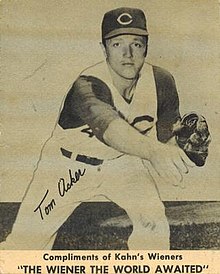
Thomas James Acker (March 7, 1930 – January 4, 2021) was an American baseball pitcher who played his entire career for the Cincinnati Reds in four seasons of Major League Baseball (MLB) from 1956 to 1959. He batted and threw right-handed and served primarily as a relief pitcher.
Acker was signed as an amateur free agent by the New York Giants in 1948 and played for two of their minor league affiliates until 1950, when the Buffalo Bisons drafted him in that year's minor league draft. After spending one season with the organization, he was traded to the Cincinnati Reds in October 1951, the same month he drafted into the US Army. As a result, he missed the 1952 and 1953 seasons. Upon his return from the army, he pitched in the minors until 1956, when the Redlegs promoted him to the major leagues. He played his last game on September 20, 1959, and subsequently worked at the Meadowlands Racetrack from its opening in 1976 until 1992. (Full article...) -
Image 14
Chauncey Edward Archiquette (November 17, 1877 – March 12, 1949) was an American athlete. A member of the Oneida people, he played several sports while attending Carlisle Indian Industrial School and then Haskell Institute. He later played for several barnstorming teams and coached at Haskell. While attending Haskell, Archiquette captained the football team and was the idol of a young Jim Thorpe, a Native American who went on to be considered one of the greatest athletes of all time. (Full article...) -
Image 15
Frank Daryl Tanana (born July 3, 1953) is an American former professional baseball left-handed pitcher. In a Major League Baseball career that stretched from 1973 to 1993, he pitched for the California Angels, Boston Red Sox, Texas Rangers, Detroit Tigers, New York Mets, and New York Yankees. He struck out 2,773 batters in his career and twice won playoff-clinching games for the teams he was on, the 1979 Angels and the 1987 Tigers.
Raised in northwest Detroit, Tanana was a first-round draft pick by the Angels in 1971. He made his debut with the team in 1973 and won 14 games his rookie year. Tanana and fellow starter Nolan Ryan formed one of the toughest pairs of starting pitchers to hit against in baseball. Tanana led the American League (AL) in strikeouts in 1975, then made the AL All-Star team three years in a row. He won 19 games in 1976 and led the AL with a 2.54 earned run average (ERA) in 1977. In 1979, he won the game that clinched the Angels' first-ever playoff appearance. Injuries began to take their toll on him by the end of his tenure with the Angels, and he changed his style from relying on a hard fastball to throwing a repertoire of slower pitches, using deception to get hitters out instead. (Full article...)
Did you know (auto-generated) - load new batch

- ... that baseball player Mark Littell developed an anatomically correct athletic cup called the "Nutty Buddy"?
- ... that a painting by Major League Baseball player Gene Locklear was hung in the White House?
- ... that Bill Duplissea has been said to have the "best eyes in baseball"?
- ... that before he made his Major League Baseball debut, Nate Fisher worked as a commercial lending analyst for the First National Bank of Omaha?
- ... that the only run scored by John Gamble was a game-winner?
- ... that Cam Booser retired from baseball to work as a carpenter in 2017 and made it to Major League Baseball in 2024?
- ... that thirty years after playing his first season for the Miami Hurricanes, J. D. Arteaga became the team's head coach in 2024?
- ... that Frankie Saluto was a member of the Ringling Giants, a dwarf baseball team that raised money for charity?
Quotes
| It breaks your heart. It is designed to break your heart. The game begins in the spring, when everything else begins again, and it blossoms in the summer, filling the afternoons and evenings, and then as soon as the chill rains come, it stops and leaves you to face the fall alone. |
 Featured lists - load new batch
Featured lists - load new batch
-
Image 1

Robin Yount (1973) is one of two Brewers first-round picks to be inducted in the National Baseball Hall of Fame.
The Milwaukee Brewers are a Major League Baseball (MLB) franchise based in Milwaukee, Wisconsin. They play in the National League Central division. Established in Seattle, Washington, as the Seattle Pilots in 1969, the team became the Milwaukee Brewers after relocating to Milwaukee in 1970. The franchise played in the American League until 1998, when it moved to the National League in conjunction with a major league realignment. Since the institution of MLB's Rule 4 draft, the Brewers have selected 69 players in the first round. Officially known as the "First-Year Player Draft", the Rule 4 draft is MLB's primary mechanism for assigning players from high schools, colleges, and other amateur clubs to its franchises. The draft order is determined based on the previous season's standings, with the team possessing the worst record receiving the first pick. In addition, teams which lost free agents in the previous off-season may be awarded compensatory or supplementary picks.
Of the 71 players picked in the first round by Milwaukee, 28 have been pitchers, the most of any position; 18 of these were right-handed, while 10 were left-handed. Fifteen outfielders, 13 shortstops, 5 third basemen, 4 first basemen, 3 catchers, and 3 second basemen were also taken. Fifteen of the players came from high schools or universities in the state of California, and Florida follows with ten players. (Full article...) -
Image 2
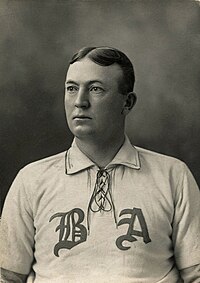
Cy Young is the all-time leader in wins.
In Major League Baseball, the 300-win club is the group of pitchers who have won 300 or more games. Twenty-four pitchers have reached this milestone. This list does not include Bobby Mathews who won 297 in the major leagues plus several more in 1869 and 1870 before the major leagues were established in 1871. The San Francisco Giants are the only franchise to see four players reach 300 wins while on their roster: Tim Keefe in the Players' League, Christy Mathewson and Mickey Welch while the team was in New York, and most recently Randy Johnson. Early in the history of professional baseball, many of the rules favored the pitcher over the batter; the distance pitchers threw to home plate was shorter than today, and pitchers were able to use foreign substances to alter the direction of the ball. Moreover, a schedule with rest days after most games allowed pitchers to start a far higher proportion of their team's games than modern pitchers do, typically every other game or even more (in the second half of the 1884 season Old Hoss Radbourn started 40 games out of 43). The first player to win 300 games was Pud Galvin in 1888. Seven pitchers recorded all or the majority of their career wins in the 19th century: Galvin, Cy Young, Kid Nichols, Keefe, John Clarkson, Charles Radbourn, and Welch. Four more pitchers joined the club in the first quarter of the 20th century: Mathewson, Walter Johnson, Eddie Plank, and Grover Cleveland Alexander. Young is the all-time leader in wins with 511, a mark that is considered unbreakable. If a modern-day pitcher won 20 games per season for 25 seasons, he would still be 11 games short of Young's mark.
Only three pitchers—Lefty Grove, Warren Spahn, and Early Wynn—joined the 300-win club between 1924 and 1982, which may be explained by a number of factors: the abolition of the spitball; World War II military service, such as Bob Feller's; and the growing importance of the home run in the game. As the home run became commonplace, the physical and mental demands on pitchers dramatically increased, which led to the use of a four-man starting rotation. Between 1982 and 1990, the 300-win club gained six members: Gaylord Perry, Phil Niekro, Steve Carlton, Nolan Ryan, Don Sutton, and Tom Seaver. These pitchers benefited from baseball's increase from a 154-game schedule to a 162-game schedule in 1961, and expansion of the league from 16 teams in 1960 to 26 by 1977. The increased use of specialized relief pitchers, an expanded strike zone, and new stadiums, including Shea Stadium, Dodger Stadium and the Astrodome, that were pitcher's parks all also suppressed offensive production. Also, the increasing sophistication of training methods and sports medicine - such as Tommy John surgery - allowed players to maintain a high competitive level for a longer time. Randy Johnson, for example, won more games in his 40s than he did in his 20s. (Full article...) -
Image 3In its 108-year history, the Minnesota Twins baseball franchise of Major League Baseball's American League has employed 31 managers. The duties of the manager include team strategy and leadership on and off the field. Eight of these team managers have been "player-managers", all during the Washington Senators era; specifically, they managed the team while still playing for it.
The Minnesota franchise began its life as the Washington Senators in Washington, D. C., where they played from their inception in 1901 to 1960. In the early twentieth century, the Senators were managed consecutively by three future members of the National Baseball Hall of Fame, bookended by Bucky Harris, who managed the team from 1924 to 1928 and again from 1935 to 1942. Walter Johnson managed the team for four seasons from 1929 to 1932, and he was followed by Joe Cronin, who led for the next two seasons (1933–1934). In 1960, the American League awarded an expansion franchise to Minneapolis, Minnesota; however, owner Calvin Griffith moved his team to Minnesota, and Washington was awarded the expansion team instead. Thus, the Minnesota Twins began play at Metropolitan Stadium in Bloomington, Minnesota the following year, during the tenure of manager Cookie Lavagetto, and played at the Hubert H. Humphrey Metrodome in downtown Minneapolis from 1982 to 2009. Under manager Ron Gardenhire, the team moved to Target Field beginning in the 2010 season. (Full article...) -
Image 4
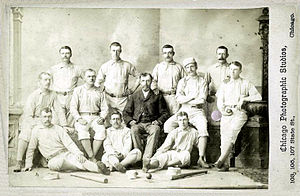
1882 Providence Grays
The Providence Grays were a Major League Baseball franchise based in Providence, Rhode Island from 1878 to 1885. During the team's eight seasons in the National League (NL), which then comprised eight teams, they finished third place or higher in the final standings seven times, and won the league championship in both 1879 and 1884. Providence played their home games at the Messer Street Grounds, which was located in the Olneyville neighborhood of Providence. The Grays were officially organized on January 16, 1878 by Benjamin Douglas, who became the team's general manager. Henry Root was hired as the team president‚ and Tom Carey was initially hired to be the on-field captain, whose duties were similar to the modern-day manager. On January 21, 1878, Providence applied for membership in the NL, and was officially approved on February 6. On April 10, Root took over ownership of the team, fired Douglas for incompetence and insubordination, and hired Tom York to replace Carey as captain.
Providence was successful in signing several star players for their inaugural season: Paul Hines had played the previous four seasons with the Chicago White Stockings; Tom Carey was signed after the Hartford Dark Blues folded; Doug Allison was the catcher for the 1869 Cincinnati Red Stockings, who had an 84-game winning streak from 1869 to 1870; and John Montgomery Ward, who was playing his first season in the major leagues. Ward had a win–loss record of 22–13 and Hines led the league in home runs, runs batted in (RBIs), and batting average as the Grays finished in third place among the six teams in the NL for the 1878 season, with a record of 33 wins, 27 losses, and 2 ties. The Grays won the NL championship in 1879, placing first among the league's eight teams with Ward winning 47 games as their starting pitcher, and the leadership of George Wright, who played second base and also managed. The team had a strong hitting line-up with Hines' league leading .357 batting average, as well as new additions Jim O'Rourke and Joe Start, who both had batting averages over .300. William Edward White, a Brown University player who played one game for the Grays on June 21, 1879, may have been the first African-American to play at the major league level; according to Peter Morris of the Society for American Baseball Research, the evidence for White is strong, but not conclusive. If this claim is true, then White pre-dated both Moses Fleetwood Walker and his brother Weldy Walker, who both played for the 1884 Toledo Blue Stockings of the American Association (AA). In 1880, the Grays finished in second place among the eight NL teams, with Ward winning 39 games. On June 17 of that year, Ward pitched the second perfect game in major league history. (Full article...) -
Image 5The Cleveland Guardians (formerly known as the Indians) are a professional baseball franchise based in Cleveland, Ohio that formed in 1901. They are members of the Central division of Major League Baseball's American League. The current manager of the Guardians is Stephen Vogt, who replaced Terry Francona after he stepped down at the end of the 2023 season.
Cleveland has had 47 managers in their major league history. Jimmy McAleer became the first manager of the then Cleveland Blues in 1901, serving for one season. In 1901, McAleer was replaced with Bill Armour. Cleveland made their first playoff appearance under Tris Speaker in 1920. Out of the eight managers that have led Cleveland into the postseason, only Speaker and Lou Boudreau have led Cleveland to World Series championships, doing so in 1920 and 1948, respectively. Al López (1954), Mike Hargrove (1995 and 1997) and Terry Francona (2016) have also appeared in World Series with Cleveland. The highest winning percentage of any manager who managed at least one season was López, with a percentage of .617. The lowest percentage was Johnny Lipon's .305 in 1971, although he managed for only 59 games. The lowest percentage of a manager with at least one season with Cleveland was McAleer's .397 in 1901. (Full article...) -
Image 6
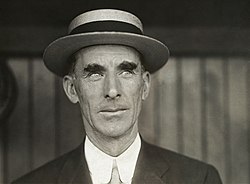
Connie Mack holds the records for most wins (3,731) and losses (3,948) by a Major League Baseball manager.
Major League Baseball (MLB) is the highest level of play in North American professional baseball and is the organization that operates the National League and the American League. In 2000, the two leagues were officially disbanded as separate legal entities, and all of their rights and functions were consolidated in the commissioner's office. Since that time, MLB has operated as a single league. Composed of 30 teams, MLB is one of the four major professional sports leagues in the United States and Canada.
Each team in the league has a manager who is responsible for team strategy and leadership on and off the field. Assisted by various coaches, the manager sets the line-up and starting pitcher before each game and makes substitutions throughout the game. In early baseball history, it was not uncommon for players to fill multiple roles as player-managers; specifically, they managed the team while still being signed to play for the club. The last player-manager in Major League Baseball was Pete Rose, who began managing the Cincinnati Reds in 1984. (Full article...) -
Image 7The Texas Rangers are an American baseball franchise based in Arlington, Texas. They are members of the American League West division. The Rangers franchise was formed in 1961, then called the Washington Senators, as a member of the American League. In its 62-year history, the Texas Rangers baseball franchise of Major League Baseball's American League has employed 28 managers. The duties of the team manager include team strategy and leadership on and off the field.
Mickey Vernon became the first manager of the then Washington Senators in 1961, serving for just over two seasons. Ron Washington has managed more games and seasons than any other manager in Rangers history. Before 2010, the only Rangers manager to have led the team to the playoffs was Johnny Oates, who also won the 1996 Manager of the Year Award with the Rangers. Ted Williams is the only Rangers manager to have been inducted into the Baseball Hall of Fame as a player; Whitey Herzog, who was inducted in the Hall in 2010, is only Rangers manager to earn induction as a manager. (Full article...) -
Image 8

Tim Dillard is the Sounds' career leader in wins (48), games pitched (242), innings pitched (710), and strikeouts (437).
The Nashville Sounds Minor League Baseball team has played in Nashville, Tennessee, since being established in 1978 as an expansion team of the Double-A Southern League. They moved up to Triple-A in 1985 as members of the American Association before joining the Pacific Coast League in 1998. The team was placed in the Triple-A East in 2021 prior to this becoming the International League in 2022. In the history of the franchise, numerous players and teams have set records in various statistical areas during single games, entire seasons, or their Sounds careers.
Of the nine Sounds who hold the 19 career records tracked by the team, Tim Dillard holds the most, with seven. He is followed by Skeeter Barnes and Chad Hermansen, with three each; and Keith Brown, Mark Corey, Hugh Kemp, Otis Nixon, Tike Redman, and Joey Wendle, with one apiece. Dillard holds the most franchise records, with eight. He is followed by Jamie Werly, with six; and Steve Balboni and Skeeter Barnes, who hold four records each. (Full article...) -
Image 9
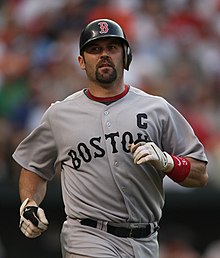
Jason Varitek, who has caught a record four no-hitters, was a selected by the American Baseball Coaches Association, Baseball America, and Collegiate Baseball.
An All-American team is an honorary sports team composed of the best amateur players of a specific season for each position—who in turn are given the honorific "All-America" and typically referred to as "All-American athletes", or simply "All-Americans". Although the honorees generally do not compete as a unit, the term is used in United States team sports to refer to players who are selected by members of the national media. Walter Camp selected the first All-America team in the early days of American football in 1889. In 1950, the American Baseball Coaches Association (ABCA) selected its first All-American baseball team. It has since chosen All-American teams and a player of the year for each division (National Collegiate Athletic Association (NCAA) Division I, Division II, Division III, National Association of Intercollegiate Athletics, junior college and high school). Collegiate Baseball selects All-American, Freshman All-American and High School All-American teams. Baseball America selects pre-season and post-season All-American teams and College Player of the Year honorees.
Various organizations selected All-American lists of the best players for the 1992 NCAA Division I college baseball season. The ABCA, the magazine Baseball America, and Collegiate Baseball were the NCAA-sanctioned selectors. This list only includes players selected to the post-season All-American first team for each selector. However, many All-American selections choose second, third, etc. teams from the remaining eligible candidates. (Full article...) -
Image 10

Ted Williams has the highest career on-base percentage in MLB history, led the American League in 12 seasons (also a record), and held the single-season on-base percentage record for 61 years.
In baseball statistics, on-base percentage (OBP) is a measure of how often a batter reaches base for any reason other than a fielding error, fielder's choice, dropped or uncaught third strike, fielder's obstruction, or catcher's interference. OBP is calculated in Major League Baseball (MLB) by dividing the sum of hits, walks, and times hit by a pitch by the sum of at-bats, walks, times hit by pitch and sacrifice flies. A hitter with a .400 on-base percentage is considered to be great and rare; only 61 players in MLB history with at least 3,000 career plate appearances (PA) have maintained such an OBP. Left fielder Ted Williams, who played 19 seasons for the Boston Red Sox, has the highest career on-base percentage, .4817, in MLB history. Williams led the American League (AL) in on-base percentage in twelve seasons, the most such seasons for any player in the major leagues. Barry Bonds led the National League (NL) in ten seasons, a NL record. Williams also posted the then-highest single-season on-base percentage of .5528 in 1941, a record that stood for 61 years until Bonds broke it with a .5817 OBP in 2002. Bonds broke his own record in 2004, setting the current single-season mark of .6094.
Players are eligible for the Hall of Fame if they have played at least 10 major league seasons, have been either retired for five seasons or deceased for six months, and have not been banned from MLB. These requirements leave 6 living players ineligible who have played in the past 5 seasons; 5 players (Bill Joyce, Ferris Fain, Jake Stenzel, Bill Lange, and George Selkirk) who did not play 10 seasons in MLB; and Shoeless Joe Jackson, who was banned for his role in the Black Sox Scandal. (Full article...) -
Image 11
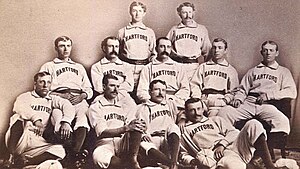
Members of the 1876 Hartford Dark Blues
The Hartford Dark Blues were a Major League Baseball club in the 1870s, based in Hartford, Connecticut, for three seasons and in Brooklyn, New York, for one. Hartford was a member of the National Association (NA), 1874–1875 and a founding member of the National League (NL) in 1876, when it played home games at the Hartford Ball Club Grounds. During 1877 the team played home games at the Union Grounds in Brooklyn and was sometimes called the Brooklyn Hartfords.
The team's owner, Morgan Bulkeley, who later became the first president of the NL in 1876, established the franchise in 1874; he gave the on-field captain duties to Lip Pike, who was also the starting center fielder. Among the other players signed by Hartford were pitcher Cherokee Fisher, who had led the NA in earned run average the two previous seasons, second baseman Bob Addy, and Scott Hastings. (Full article...) -
Image 12
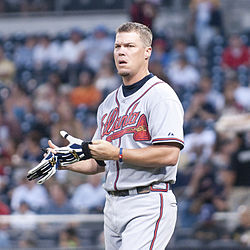
Chipper Jones won the National League MVP Award in 1999, four years after winning a World Series ring.
The Atlanta Braves are a Major League Baseball (MLB) franchise based in Atlanta, Georgia. They play in the National League East division. Officially known as the "First-Year Player Draft", the Rule 4 Draft is MLB's primary mechanism for assigning players from high schools, colleges, and other amateur clubs to its franchises. The draft order is determined based on the previous season's standings, with the team possessing the worst record receiving the first pick. In addition, teams which lost free agents in the previous off-season may be awarded compensatory or supplementary picks. Since the establishment of the draft in 1965, the Braves have selected 56 players in the first round.
Of those 56 players, 27 have been pitchers, the most of any position; 15 of these were right-handed, while 12 were left-handed. The Braves have also selected eight outfielders, seven shortstops, five catchers, four third basemen, three first basemen, and two second basemen in the initial round of the draft. The franchise has drafted nine players from colleges or high schools in the state of Florida, more than any other state. Eight more selections have come from their home state of Georgia. Two selections have come from outside the 50 United States: Luis Atilano (2003) is from the Commonwealth of Puerto Rico, and Scott Thorman (2000) is from Ontario, Canada. (Full article...) -
Image 13
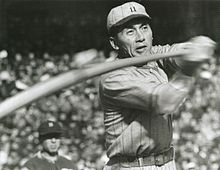
Fumio Fujimura was the first player in Nippon Professional Baseball history to hit for the cycle and also the first to hit multiple cycles.
In baseball, completing the cycle is the accomplishment of hitting a single, a double, a triple, and a home run in the same game. Collecting the hits in that order is known as a "natural cycle", which has occurred five times in Nippon Professional Baseball (NPB). The cycle itself is rare in NPB, occurring 76 times since Fumio Fujimura's first cycle during the single league era in 1948. In terms of frequency, the cycle is roughly as common as a no-hitter (90 occurrences in NPB history); Baseball Digest calls it "one of the rarest feats in baseball". Hitting for the cycle was not recognized in Japanese professional baseball until former Major League Baseball (MLB) player Daryl Spencer made a remark about it after hitting for the cycle with the Hankyu Braves in 1965. Of the 12 current NPB teams, only the Tohoku Rakuten Golden Eagles have never had at least one player hit for the cycle.
The most cycles hit by a player in Nippon Professional Baseball is three, accomplished by Bobby Rose. Playing for the Yokohama BayStars, Rose hit his first cycle on May 2, 1995, the next on April 29, 1997, and his final cycle on June 30, 1999. Other than Rose, only three other NPB players have hit multiple cycles: Fumio Fujimura with the Osaka Tigers and Hiromi Matsunaga with the Hankyu/Orix Braves and Kosuke Fukudome with the Chunichi Dragons and the Hanshin Tigers, all with two. Fujimura is also the only player to have hit a cycle during both the single league era and the current dual league era. The 2003 NPB season saw the most cycles hit in a single season—five. That season also saw the only instance of cycles occurring in two different games on the same day: on July 1, hit by Atsunori Inaba of the Yakult Swallows and Arihito Muramatsu of the Fukuoka Daiei Hawks. The next day, Shinjiro Hiyama became the third player to hit for the cycle in two days. Conversely, the longest period of time between two players hitting for the cycle is one day shy of 6 years. The drought has lasted from Michihiro Ogasawara's cycle in 2008 until Rainel Rosario's in 2014. (Full article...) -
Image 14
Citi Field is the home stadium of the Mets.
The New York Mets are an American professional baseball team based in Flushing, Queens, New York City. They compete in the East Division of Major League Baseball's (MLB) National League (NL). The team's current home stadium is Citi Field, after playing two years at the Polo Grounds and 45 years at Shea Stadium. Since their inception in 1962, the Mets have won two World Series titles and five NL championships. As of the end of the 2024 season, the Mets have won more than 4,800 regular season games, a total that ranks 20th among MLB teams and fourth among expansion teams.
The Mets lost 120 games in their inaugural season, the second-most by an MLB team behind the 2024 Chicago White Sox. After six more years in which their best league finish was ninth, the Mets won the World Series in 1969, defeating the Baltimore Orioles in five games to earn what is widely considered one of the biggest upsets in baseball history. Four seasons later, the Mets returned to the World Series, where they lost to the Oakland Athletics in seven games. After winning two NL championships in five years, New York struggled for the next decade, not coming within 10 games of the NL East leader until 1984. (Full article...) -
Image 15

The Yankees have played home games in the current Yankee Stadium since 2009.
The New York Yankees are a professional baseball team based in the Bronx, a borough of New York City. Also known as "the Bronx Bombers" and "the Pinstripers", the Yankees play in the East Division of Major League Baseball's (MLB) American League (AL). In its 121 MLB seasons, the franchise has won 27 World Series championships, the most of any MLB team and 16 more than the second-place St. Louis Cardinals. The Yankees played home games in Yankee Stadium from 1923 to 2008, except for a stint at Shea Stadium from 1974 to 1975 while Yankee Stadium was undergoing renovations. In 2009, the team moved into a new ballpark, which is also called Yankee Stadium.
The Baltimore Orioles began play in the AL in 1901. After two seasons, the Orioles were replaced by a club in New York; it is unclear whether it was an expansion team or a relocated version of the Orioles. Frank Farrell and William S. Devery purchased the franchise, naming it the New York Highlanders. In 1913, the team changed its name to the Yankees. From 1921 to 1964, the Yankees were the most successful MLB franchise, winning 20 World Series titles and 29 AL pennants. This period included streaks of four consecutive championships from 1936 to 1939 and five straight titles from 1949 to 1953. (Full article...)
More did you know
- ... that the San Francisco Giants drafted Brock Bond when they meant to draft Casey Bond?
- ... that Eddie Gillette led the Wisconsin Badgers football team to an undefeated season and in baseball "beat some of the best pitchers in the 'Three-Eye League'"?
- ... that the 2005 book Baseball Before We Knew It brought new evidence of the origins of baseball into play?
- ... that in baseball, no Gold Glove Award-winning catcher posted an errorless season until Charles Johnson and Mike Matheny accomplished the feat twice in six years?
- ... that Bob "Horse" Reynolds founded the Los Angeles Angels baseball team and was inducted into the College Football Hall of Fame within a year?
- ... that Red Snapp was considered the "king of the minor leagues"?
Sports portals
Selected picture
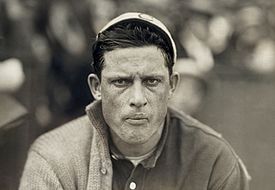
| Credit: Paul Thompson |
Edward Augustine Walsh (May 14, 1881 – May 26, 1959) was a Major League Baseball pitcher. He holds the record for lowest career ERA, 1.82. Born in Plains Township, Pennsylvania, Walsh had a brief though remarkable major league career. He made his major league debut in 1904 with the Chicago White Sox and pitched his first full season in 1906, going 17-13 with a 1.88 ERA and 171 strikeouts.
Associated Wikimedia
The following Wikimedia Foundation sister projects provide more on this subject:
-
Commons
Free media repository -
Wikibooks
Free textbooks and manuals -
Wikidata
Free knowledge base -
Wikinews
Free-content news -
Wikiquote
Collection of quotations -
Wikisource
Free-content library -
Wikiversity
Free learning tools -
Wiktionary
Dictionary and thesaurus
More portals
- Pages using the Phonos extension
- Pages including recorded pronunciations
- Pages with Spanish IPA
- Portals with triaged subpages from June 2018
- All portals with triaged subpages
- Portals with no named maintainer
- Automated article-slideshow portals with 51–100 articles in article list
- Automated article-slideshow portals with 501–1000 articles in article list
- Random portal component with 41–50 available subpages
- Automated article-slideshow portals with 201–500 articles in article list
- Random portal component with 11–15 available subpages
- Random portal component with 21–25 available image subpages



